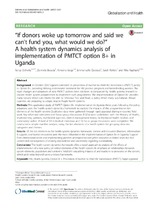| dc.contributor.author | Doherty, Tanya | |
| dc.contributor.author | Besada, Donela | |
| dc.contributor.author | Goga, Ameena | |
| dc.contributor.author | Daviaud, Emmanuelle | |
| dc.contributor.author | Rohde, Sarah | |
| dc.contributor.author | Raphaely, Nika | |
| dc.date.accessioned | 2018-09-03T08:08:29Z | |
| dc.date.available | 2018-09-03T08:08:29Z | |
| dc.date.issued | 2017 | |
| dc.identifier.citation | Doherty, T. et al. (2017). “If donors woke up tomorrow and said we can't fund you, what would we do?” A health system dynamics analysis of implementation of PMTCT option B+ in Uganda. Globalization and Health, 13(51) | en_US |
| dc.identifier.uri | http://dx.doi.org/10.1186/s12992-017-0272-2 | |
| dc.identifier.uri | http://hdl.handle.net/10566/3990 | |
| dc.description.abstract | BACKGROUND: In October 2012 Uganda extended its prevention of mother to child HIV transmission (PMTCT) policy
to Option B+, providing lifelong antiretroviral treatment for HIV positive pregnant and breastfeeding women. The
rapid changes and adoptions of new PMTCT policies have not been accompanied by health systems research to
explore health system preparedness to implement such programmes. The implementation of Option B+ provides
many lessons which can inform the shift to ‘Universal Test and Treat’, a policy which many sub-Saharan African
countries are preparing to adopt, despite fragile health systems.
METHODS: This qualitative study of PMTCT Option B+ implementation in Uganda three years following the policy
adoption, uses the health system dynamics framework to explore the impacts of this programme on ten
elements of the health system. Qualitative data were gathered through rapid appraisal during in-country field
work. Key informant interviews and focus group discussions (FGDs) were undertaken with the Ministry of Health,
implementing partners, multilateral agencies, district management teams, facility-based health workers and
community cadres. A total of 82 individual interviews and 16 focus group discussions were completed. We
conducted a simple manifest analysis, using the ten elements of a health system for grouping data into
categories and themes.
RESULTS: Of the ten elements in the health system dynamics framework, context and resources (finances, infrastructure
& supplies, and human resources) were the most influential in the implementation of Option B+ in Uganda. Support
from international actors and implementing partners attempted to strengthen resources at district level, but had
unintended consequences of creating dependence and uncertainty regarding sustainability.
CONCLUSIONS: The health system dynamics framework offers a novel approach to analysis of the effects of
implementation of a new policy on critical elements of the health system. Its emphasis on relationships between
system elements, population and context is helpful in unpacking impacts of and reactions to pressures on the system,
which adds value beyond some previous frameworks. | en_US |
| dc.language.iso | en | en_US |
| dc.publisher | BioMed Central | en_US |
| dc.rights | © The Author(s). 2017 Open Access This article is distributed under the terms of the Creative Commons Attribution 4.0
International License (http://creativecommons.org/licenses/by/4.0/), which permits unrestricted use, distribution, and
reproduction in any medium, provided you give appropriate credit to the original author(s) and the source, provide a link to
the Creative Commons license, and indicate if changes were made. The Creative Commons Public Domain Dedication waiver
(http://creativecommons.org/publicdomain/zero/1.0/) applies to the data made available in this article, unless otherwise stated. | |
| dc.subject | HIV | en_US |
| dc.subject | Health systems | en_US |
| dc.subject | Option B + | en_US |
| dc.subject | Prevention of mother to child HIV transmission (PMTCT) | en_US |
| dc.subject | Rapid appraisal | en_US |
| dc.title | “If donors woke up tomorrow and said we can't fund you, what would we do?” A health system dynamics analysis of implementation of PMTCT option B+ in Uganda. | en_US |
| dc.type | Article | en_US |
| dc.privacy.showsubmitter | FALSE | |
| dc.status.ispeerreviewed | TRUE | |
| dc.description.accreditation | ISI | |

